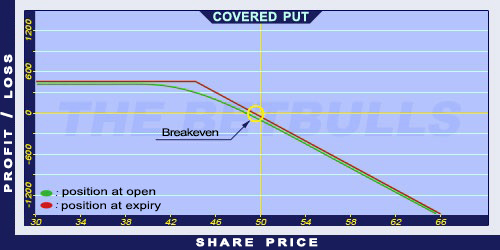Description and use
A Covered Put option is the opposite of a Covered Call. The main idea is to short shares and sell a short term OTM Put option. The direction of the market is neutral/decreasing, the investor expects constant decrease on the market. The strategy is a net credit investment. The Put options are sold on a monthly basis. If the share stays below the strike price, the option will be exercised and the investor buys the shares. If the price stagnates, the investor can keep the premium received for the Put option. Therefore, a Covered Put position is the sale of the share and the agreement to buy the share if the option is exercised.
- Type: Neutral, Bearish
- Transaction type: Debit
- Maximum profit: Limited
- Maximum loss: Unlimited
- Strategy: Income strategy
Opening the position
- Sell the share.
- Sell the OTM Put option.
Steps
Entry:
- Make sure the trend is inclining or stagnating at a certain level.
Exit:
- If the shares close above the strike price at expiry, then the option will be exercised. The investor will have to buy back the shares at strike price. The profit will be the received premium minus the decrease in the share price.
- If the share price is above the strike price but below the Stop Loss at expiration, then the Short Put option should be left to expire worthless and the received premium should be kept. Then another Put option can be sold the next month.
- If the share price is below the Stop Loss at expiration then either the shares should be buy backd or the trader should start trading in opposite position.
Basic characteristics
Maximum loss: Unlimited.
Maximum profit: (Strike price - share price) + premium.
Time decay: Time decay has a positive effect on the value. If shares do not reach the strike price, the investor can keep the whole premium and decrease his costs.
Breakeven point: Strike price + premium.
Advantages and disadvantages
Advantages:
- It generates monthly profit.
- The risk is lower than selling the shares.
- The investor can profit from share prices moving within given limits as well.
Disadvantages:
- The strategy is said to be expensive because it involves high paying in cash.
- The increase is limited when the share prices fall.
- The decrease is unlimited if the share prices increase.
Closing the position
Closing the position:
- When the share price is below strike price, the option will be exercised and a limited profit will be generated.
- When the share price is above strike price, the position will be lossmaking.
- When the share prices increase, the closing of the position depends on whether the investor can sell naked options. If the answer is yes, the investor is exposed to possible unlimited losses. If the answer is no, the investor should buy back the sold options and shares. This is the safest way to close a lossmaking position.
Mitigation of losses:
- Either buy back the shares or buy back the shares and the Short Put option.
Example
ABCD is traded for $50.00 on 25.02.2017. The investor sells a share for $49.75. Then the investor sells a Short Put option which has a strike price of $45.00, expires in March 2017. and costs $1.50 (premium).
Price of the underlying (share price): S= $50.00
Share price: ShP= $49.75
Premium (Put): P= $1.50
Strike price: K= $45.00
Credit: Cr
Maximum loss: R
Maximum profit: Pr
Breakeven point: BEP
Credit: Cr = ShP + P
Maximum loss (risk): Unlimited
Maximum profit: Pr = (ShP - K) + P
Breakeven point: BEP = ShP + P
Cr= $51.25
R = unlimited
Pr = $6.25
BEP = $51.25














